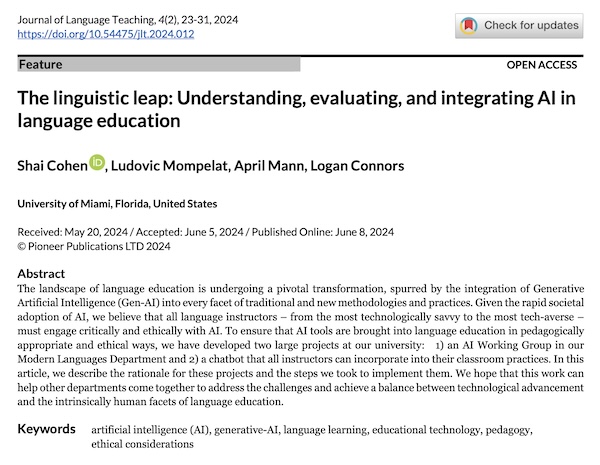The linguistic leap: Understanding, evaluating, and integrating AI in language education
DOI:
https://doi.org/10.54475/jlt.2024.012Keywords:
artificial intelligence, generative-AI, language learning, educational technology, pedagogy, ethical considerationsAbstract
The landscape of language education is undergoing a pivotal transformation, spurred by the integration of Generative Artificial Intelligence (Gen-AI) into every facet of traditional and new methodologies and practices. Given the rapid societal adoption of AI, we believe that all language instructors – from the most technologically savvy to the most tech-averse – must engage critically and ethically with AI. To ensure that AI tools are brought into language education in pedagogically appropriate and ethical ways, we have developed two large projects at our university: 1) an AI Working Group in our Modern Languages Department and 2) a chatbot that all instructors can incorporate into their classroom practices. In this article, we describe the rationale for these projects and the steps we took to implement them. We hope that this work can help other departments come together to address the challenges and achieve a balance between technological advancement and the intrinsically human facets of language education.
References
Burdick, A., et al. (2012) Humanities to digital humanities. MIT Press. https://doi.org/10.7551/mitpress/9248.001.0001 DOI: https://doi.org/10.7551/mitpress/9248.001.0001
Burstein, J., Tetreault, J., & Madnani, N. (2013). The e-rater® automated essay scoring system. In M. D. Shermis & J. Burstein (Eds.), Handbook of automated essay evaluation: Current applications and new directions. Routledge/Taylor & Francis Group. 55-67. https://psycnet.apa.org/record/2013-15323-004
Celik, I., Dindar, M., Muukkonen, H., & Järvelä, S. (2022). The promises and challenges of artificial intelligence for teachers: A systematic review of research. TechTrends, 66(4), 616-630. https://doi.org/10.1007/s11528-022-00715-y DOI: https://doi.org/10.1007/s11528-022-00715-y
Cuban, L. (2001). Oversold and underused: Computers in the classroom. Harvard University Press. DOI: https://doi.org/10.4159/9780674030107
Firat, M. (2023). What ChatGPT means for universities: Perceptions of scholars and students. Journal of Applied Learning and Teaching, 6(1), 57-63. https://10.37074/jalt.2023.6.1.22 DOI: https://doi.org/10.37074/jalt.2023.6.1.22
Gaudioso, E., Montero, M., & Hernandez-del-Olmo, F. (2012). Supporting teachers in adaptive educational systems through predictive models: A proof of concept. Expert Systems with Applications, 39(1), 621-625. https://doi.org/10.1016/j.eswa.2011.07.052 DOI: https://doi.org/10.1016/j.eswa.2011.07.052
Godwin-Jones, R. (2019). Telecollaboration as an approach to developing intercultural communication competence. In Emerging technologies: Artificial intelligence and language learning. Language Learning & Technology, 23(3), 8-28.
Hashem, R., Ali, N., El Zein, F., Fidalgo, P., & Khurma, O. A. (2024). AI to the rescue: Exploring the potential of ChatGPT as a teacher ally for workload relief and burnout prevention. Research & Practice in Technology Enhanced Learning, 19, 23. https://doi.org/10.58459/rptel.2024.19023 DOI: https://doi.org/10.58459/rptel.2024.19023
Heffernan, N. T., & Heffernan, C. L. (2014). The ASSISTments ecosystem: Building a platform that brings scientists and teachers together for minimally invasive research on human learning and teaching. International Journal of Artificial Intelligence in Education, 24, 470-497. https://doi.org/10.1007/s40593-014-0024-x DOI: https://doi.org/10.1007/s40593-014-0024-x
Heilman, M., Collins-Thompson, K., Callan, J., & Eskenazi, M. (2006). Classroom success of an intelligent tutoring system for lexical practice and reading comprehension. In Proceedings of the Ninth International Conference on Spoken Language Processing. https://doi.org/10.21437/Interspeech.2006-282 DOI: https://doi.org/10.21437/Interspeech.2006-282
Holstein, K., McLaren, B. M., & Aleven, V. (2019). Co-designing a real-time classroom orchestration tool to support teacher-AI complementarity. Journal of Learning Analytics, 6(2), 27-52. DOI: https://doi.org/10.18608/jla.2019.62.3
Ifelebuegu, A. (2023). Rethinking online assessment strategies: Authenticity versus AI chatbot intervention. Journal of Applied Learning and Teaching, 6(2), 1-8. https://doi.org/10.37074/jalt.2023.6.2.2 DOI: https://doi.org/10.37074/jalt.2023.6.2.2
Ifelebuegu, A. O., Kulume, P., & Cherukut, P. (2023). Chatbots and AI in Education (AIEd) tools: The good, the bad, and the ugly. Journal of Applied Learning and Teaching, 6(2), 1-14. https://doi.org/10.37074/jalt.2023.6.2.29 DOI: https://doi.org/10.37074/jalt.2023.6.2.29
Kelleher, J. (2019). Deep learning. The MIT Press Essential Knowledge series. DOI: https://doi.org/10.7551/mitpress/11171.001.0001
Kojima, T., Gu, S., Reid, M., Matsuo, Y., & Iwasawa, Y. (2023). Large language models are zero-shot reasoners. In 36th Conference on Neural Information Processing Systems (NeurIPS 2022).
Kolb, D.A. (1984). Experiential learning: experience as the source of learning and development. Prentice Hall.
Kuhail, M. A., Alturki, N., Alramlawi, S., & Alhejori, K. (2023). Interacting with educational chatbots: A systematic review. Education and Information Technologies, 28(1), 973-1018. https://doi.org/10.1007/s10639-022-11177-3 DOI: https://doi.org/10.1007/s10639-022-11177-3
Lewin, K., (1951). Field theory in social sciences. Harper & Row.
Luckin, R. (2018). Machine learning and human intelligence: The future of education for the 21st century. UCL IOE Press.
Mollick, E. (2023, July 1). The homework apocalypse: Fall is going to look very different this year. One Useful Thing. https://www.oneusefulthing.org/p/the-homework-apocalypse
MLA-CCCC Joint Task Force on Writing and AI. (2023). MLA-CCCC joint task force on Writing and AI working paper: Overview of the issues, statement of principles, and recommendations. Conference on College Composition and Communication. Modern Language Association. https://hcommons.org/app/uploads/sites/1003160/2023/07/MLA-CCCC-Joint-Task-Force-on-Writing-and-AI-Working-Paper-1.pdf
Pinker, S. (1994). The language instinct: How the mind creates language. William Morrow and Company. DOI: https://doi.org/10.1037/e412952005-009
Roll, I., & Wylie, R. (2016). Evolution and revolution in artificial intelligence in education. International Journal of Artificial Intelligence in Education, 26, 582-599. https://doi.org/10.1007/s40593-016-0110-3 DOI: https://doi.org/10.1007/s40593-016-0110-3
Selwyn, N. (2016). Is technology good for education?. Polity Press.
Shneiderman, B. (2020). Human-centered artificial intelligence: Three fresh ideas. AI Magazine, 41(4), 28-36. https://doi.org/10.17705/1thci.00131 DOI: https://doi.org/10.17705/1thci.00131
Siemens, L., & Burr, E. (2013). A Trip around the World: Accommodating Geographical, Linguistic and Cultural Diversity in Academic Research Teams. Literary and Linguistic Computing, 28(2), 331-343. https://doi.org/10.1093/llc/fqs018 DOI: https://doi.org/10.1093/llc/fqs018
Siemens, G. (2005). Connectivism: A learning theory for the digital age. International Journal of Instructional Technology and Distance Learning, 2(1), 1-8.
Swiecki, Z., Ruis, A. R., Gautam, D., Rus, V., & Williamson Shaffer, D. (2019). Understanding when students are active‐in‐thinking through modeling‐in‐context. British journal of educational technology, 50(5), 2346-2364. https://doi.org/10.1111/bjet.12869 DOI: https://doi.org/10.1111/bjet.12869
Terry, O. K. (2023, May 26). I’m a student. You have no idea how much we’re using ChatGPT. Chronicle of Higher Education. https://www.chronicle.com/article/im-a-student-you-have-no-idea-how-much-were-using-chatgpt
Tlili, A., Padilla-Zea, N., Garzón, J., Wang, Y., Kinshuk, K., & Burgos, D. (2023). The changing landscape of mobile learning pedagogy: A systematic literature review. Interactive Learning Environments, 31(10), 6462-6479. https://doi.org/10.1080/10494820.2022.2039948 DOI: https://doi.org/10.1080/10494820.2022.2039948

Downloads
Published
Issue
Section
License
Copyright (c) 2024 Journal of Language Teaching

This work is licensed under a Creative Commons Attribution 4.0 International License.




